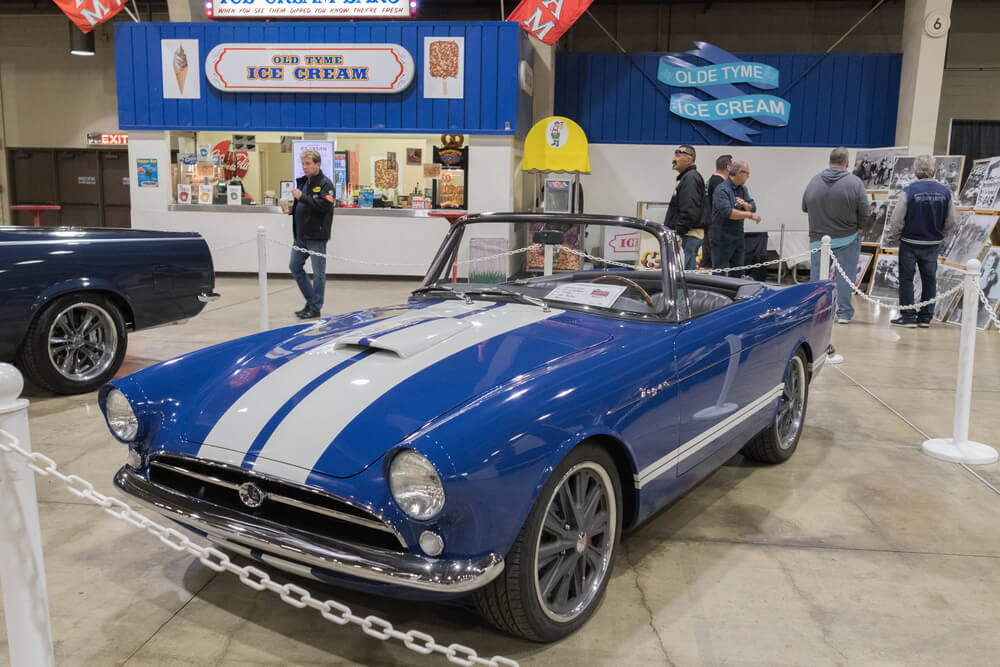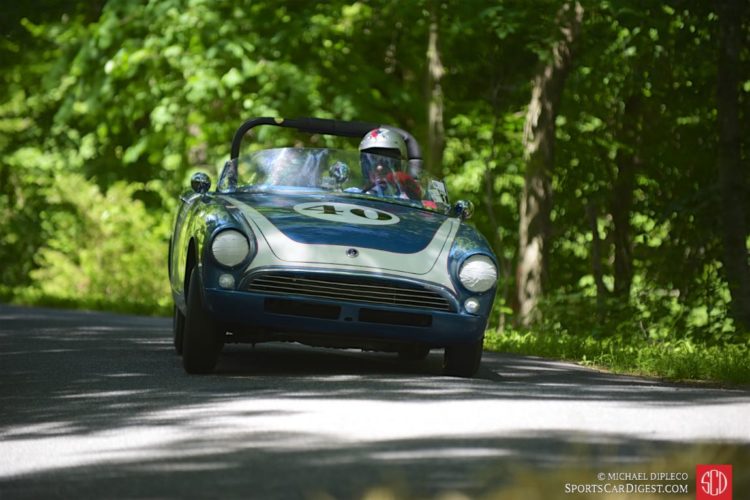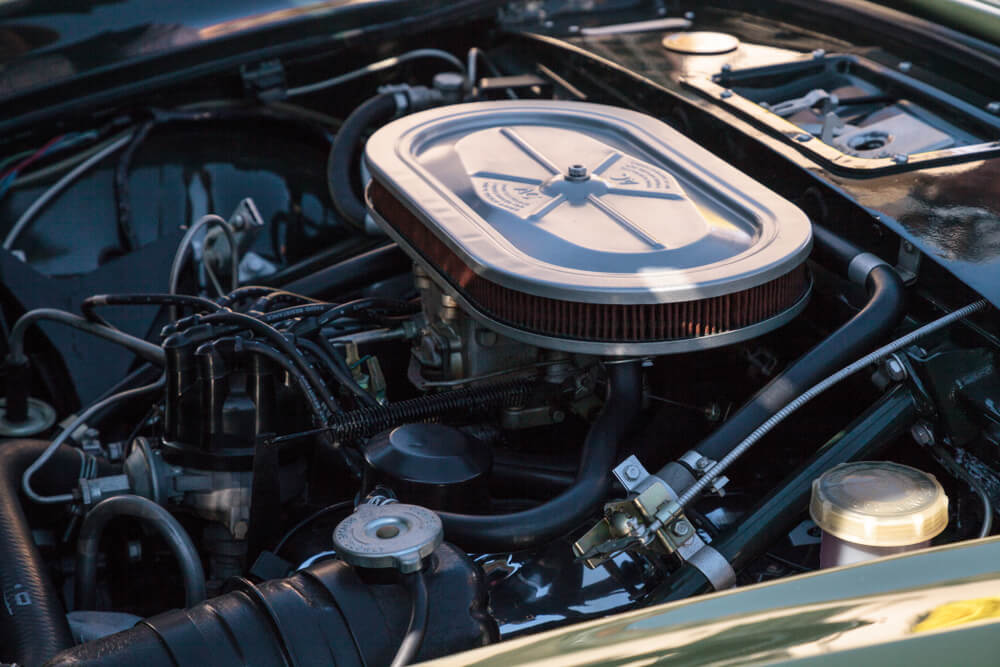The Sunbeam Tiger is an English iconic two-seater roadster, built during the 1960s by the Rootes Group of Britain to capture the American muscle car market.
At first glance, the vehicle may appear to be a docile English roadster -but looks can be deceiving. Under the hood lies an American 289 cubic inch Ford V8, producing approximately 200 horsepower, and a rumble of a classic American muscle car.
Put the foot down in a Mk I, and it’s capable to accelerate from 0-60mph in about 9 seconds, with a top speed of 120 mph.
If you think the Tiger looks mighty familiar then your probably right. The vehicle was seen on the television nightly during the introduction to the classic TV Comedy ‘Get Smart.’ The introduction had Don Adams, AKA ‘Agent Maxwell Smart’ spinning around the corner in his red Sunbeam Tiger.
The Lead-up to the Tiger

The Alpine was created for targeting the American sports car market and was competing with the likes of MG and Triumph.
With the dawning of the V8 muscle car in the 60s, the Alpines 1.5L engine needed a makeover to stay competitive, which leads us to the Tiger.
The Making of the Sunbeam Tiger
The earliest relative of the vehicle was the Sunbeam Alpine, a British 2 door roadster with a small 1.5L 4-cylinder engine.
In the mid-1960s, the Sunbeam company knew they needed an engine that could compete with the upcoming V8 American muscle car market.
Ian Garrad, the United States West Coast manager for the Rootes Group, commissioned the legendary American racing and car builder, Carroll Shelby, to revamp the Alpine with more speed and power into the roadster. On asking Carroll Shelby for the costs and timeframe to build the prototype he estimated $10,000 and eight weeks.
Carroll Shelby was the perfect choice as he had already proven with great success in bringing together an American V8 into British sports cars (AC Shelby Cobra).
They decided on using the 260 cubic inch Ford V8 engine. This engine was small and compact enough to fit snuggly into the Apline engine bay.
A little creativity was required to fund this project and instead of presenting to the chairman, Lord Rootes, Ian approached Brian Rootes, head of sales.
Finances were tight at the time but Brian replied:
“well all right, at that price when can we start? But for God’s sake keep it quiet from Dad (Lord Rootes) until you hear from me. I’ll work the $10,000 out some way, possibly from the advertising account.”
Although Shelby started making the first prototype in April 1963, Ian Garrad also commissioned Ken Miles, to build another prototype immediately.
With a budget of $800, a Ford V8 engine, two-speed automatic transmission, and a Series II Sunbeam Alpine, Miles produced a working prototype in a week and proved the concept would work.
It was a tough ask fitting that V8 into the engine compartment but both Shelby and Miles were successful. Shelby said “I think that if the figure of speech about the shoehorn ever applied to anything, it surely did to the tight squeak in getting that 260 Ford mill into the Sunbeam engine compartment. There was a place for everything and a space for everything, but positively not an inch to spare.”
Lord Rootes, the chairman of the Rootes Group at the time, had a policy of approving all projects in his group before they were launched. He was less than impressed when he discovered that work had gone into the ‘Tiger’ without his knowledge. Nevertheless, moving beyond this, he agreed to have the Shelby prototype shipped from America in July 1963 for him and his team to assess.
It is reported that Lord Rootes was so impressed after his first test drive in the vehicle that he directly contacted Henry Ford II and ordered a massive 3000 Ford V8 engines! This order was the biggest single order received by Ford from an auto manufacturer ever.
The New York Motor Show Launch

Outwardly the car took on an appearance very little different from the Alpine Series IV (which remained in production at the same time), but under the hood, there was no mistaking the Tigers Ford V8 engine.
The Tiger was marketed as giving out two times more power than the Alpine and reaching 0-60 mph within 9 seconds.
Production of the Sunbeam Tiger
The Sunbeam Tiger started production in June 1964 less than a year after the prototype was completed. The Rootes factory situated at Ryton was not big enough to manufacture the Tiger, so the production was handed over to Jensens Motors in England.
Jensen was in a fortunate position at the time to produce the vehicle as their production of the Volvo P1800 was recently canceled, and they had worked with the Rootes group in the past.
The bodies of the car were supplied painted by Pressed Steel in Oxfordshire, and Ford of America supplied the gearboxes and the engines.
Fitting the Ford V8 into the Sunbeam required some lateral thinking and a lot of brute force. Workers would use a sledgehammer to bash in part of the painted bulkhead so that the engine could slide in snuggly.
During production, Jensen was able to assemble up to 300 Tigers in a month, which went initially to North America.
Production of the Mark I Tiger ran from June 1964 until December 1966. During this time approximately 3800 units were built. This model featured a 260 cubic inch (4.3L) version of the Ford V8 small block. It can be differentiated from the Mark 1A by the round-cornered doors and lead-filled body seams.
The Mark IA accounted for the following 2700 cars. These units also had the Ford V8 260 cubic inch V8 small block engine (164HP), but they were fitted with square-cornered doors and unfilled body seams.
Only approximately 500 Mark II were made between December 1966 and June 1967. These cars were highly sought after housing a 289 cubic inch (4.7L) Ford V8 (200HP). The exterior of the vehicle can be distinguished from the Mk I by the egg-crate grille.
The Ending for the Tiger
The 1960s were a tough decade for the Rootes Group. At the same time that Rootes was under a financial strain, Chrysler was looking to expand into the European market.
In 1967, Chrysler acquired the controlling interest of Rootes after investing £20 million. This takeover led to the production of the Tiger being wound up. The vehicle did not fit their business portfolio given it was a Ford-powered car. The production of the vehicle continued until the Ford V8 engine stock ran out in 1967.
Tiger: The Making of a Sports Car (Foulis Motoring Book)
Sunbeam Tiger Racing History

In 1964, two modified versions of the Mark I competed in the 24 Hours of Le Mans. Unfortunately, they both did not finish the race.
The vehicle had more success at the Geneva Rally that year finishing first.
One of its biggest successes the vehicle experienced in 1964 was recorded in the 200 Mile Road America Race in 1964. In that race, Ken Miles finished in 2nd behind Dan Gerber in the AC Shelby Cobra.
What is a Sunbeam Tiger Worth?
Back in 1964, a Sunbeam Tiger would set you back between $3,425-$3,716 in the USA.
These days the vehicle varies in price between $40,000 for a fair condition Tiger to upwards of $90,000 for a Tiger in excellent condition.
In 2019 at RM Sotheby’s Amelia Island Auction in Florida on March 9, a stunningly restored MK I sold for $151,200.

The beautifully restored Tiger was finished in British Racing Green and the chassis number confirmed it was an early production Tiger (Mk I). The car was presented with all original panels and retained all the proper original badges such as the Rootes Group Sunbeam logo and the “Powered by Ford 260” fender and trunk tags.
More recently at the 2020 RM Sotheby’s Amelia Island Auction, a 1967 Mk II sold for $95,200. The vehicle was restored meticulously with over 1800 hours poured into the restoration. The car was stripped to bare metal and finished in Carnival Red.
















I bought a new 1965 Tiger with the 260 cubic inch engine. I really enjoyed that car since it was a real “Q ship”always picking on Porsches.,Corvettes,etc. It happily got great mileage with that little 2 barrel carb,,so long trips were a pleasure. The top,and interior were very civilized compared to my pals Cobra. We learned to put on traction bars to stop axle hop at gymkhanas,and fast courses like the “Bay Bottom Crawl” down in the Florida Keys. I finally traded it for a Lotus 7 to go racing. Wonderful car,wonderful memories.
I want one
I’m sick. I almost bought one for $3400 in 66 when my Triumph TR3 was dying and I needed a new car. I couldn’t afford my preferred Ferrari 275gts, nor the Tiger and wound up with a 66 MGB for about $3000. It’s amazing how little that difference seems now!
I owned one for 18 hours back in 1968. A friend of my neighbor was moving to California. He had a double trailer rig already and could not take the Sunbeam. I had $600, and he was desperate. But, in the morning when my dad got the VIN to add it to the insurance, he went ballistic! A V-8 in that tiny thing?!? The insurance with my 3 non-fault wrecks was more than the house payment, and dad got my money back.
And that was that.
Could have bought a 1967 Toger in 1976 for$2200.I I wanted it bad but didn’t hav the money.I know where an Alpine sits now .Maybe ill build one n out one of my 351 windsors in it ! Oh yeah Raise some hell .